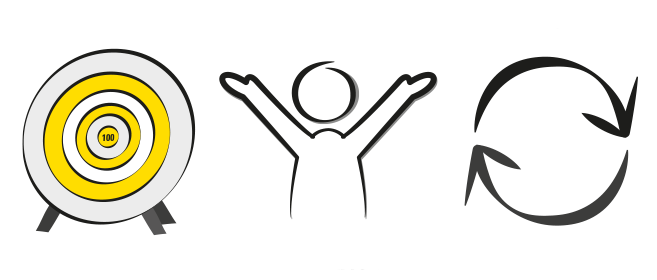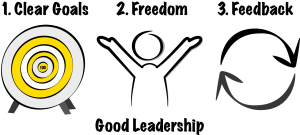
What is good leadership?
Can you remember moments in your professional life when you were particularly happy? Was there a leader who gave you the opportunity to experience this? If so, what did this leader do better than others? How did he lead?
You are probably like many other people from whom I received answers that this boss…
»was able to challenge and encourage, set clear goals, created framework conditions, was able to adapt to each individual, was able to listen, gave recognition, granted an advance of trust, had your back, stood by your employees, had a vision, set clear goals, freedom and valuable things gave feedback.” Recently I also heard: “He gave us time.”
Could these answers have come from you? Would you say that’s exactly how I want to lead or be led – but unfortunately it’s not that easy in everyday practice?

The genius is simple.
Imagine: Leadership should be a process that consists of a few, concrete steps. This process should be easy to use, repeatable and, above all, simple – because everything brilliant in the world is simple. Summarize the many good leadership resolutions into three essential, as concrete as possible steps. What is your result?
In summary, many people responded:
1. Set clear goals, 2. Leave space, 3. Give feedback.
Let’s assume you could join in this heavy compression, at least for a moment. Which of these three goals do you think a manager has the most difficulty with? 90% of all people answer spontaneously:
Number 2 – leaving space – is the biggest challenge. What do you think?
And now comes the fascinating thing: This most difficult part of leadership work is built into AGILE. In AGILE there is the so-called sprint and that is exactly the time for freedom.

My best project…
Please take a look back at your professional career to date. Of the many projects you have been involved in, which was your very best? Don’t ponder for too long, let your gut decide: What was different in this project than in all the others? What was the real reason why this project was your best?
I also asked this question to many people at all management levels, from the corporate board to the operational project team level. The answers were:
“We had clear goals,” “it was our goal,” “it was actually impossible to achieve,” “it was an enormous challenge,” “we were a small team,” “we were extremely committed,” “everyone pitched in pulled together”, “we had trust in each other”, “we had freedom”, “they let us do it”, “we were under enormous time pressure”, “we had partial successes along the way” and someone said: “We had an unconditional one Motivation!”.
If you had to choose just one criterion from the long list, which one would you choose for your next project? After a moment’s consideration, most people decide in favor of trust: trust in the team, trust in the leadership in the team and, last but not least, trust in the leadership in themselves.
Trust is obviously something very central to the success of people working together. Teams that are welded together through trust overcome obstacles more easily, manage to exceed their goals and have more fun!

How does trust arise?
If the basis for top performance is trust, then it makes a lot of sense to think about what constitutes trust at its core and how this trust can be created with greater security, right?
Reinhard Sprenger impressively described in his book, the bestseller “The Myth of Motivation,” that whenever people want to actively generate motivation, they always achieve the opposite. The only way to create motivation is to eliminate demotivating elements. Applied to trust, this means eliminating mistrust.
In this context, integrity and predictability are often spoken of when a manager does what he says. If this leader reliably does what he says, i.e. matches the word with the deed, then he achieves clarity.
Trust arises when promises and agreements, i.e. predictions for the future, become reality. This applies to the relationship with the manager, but also to the relationship between the manager and the employee. A manager gives his employee trust if he keeps his word and does what he says.

AGILE creates trust.

With AGILE, framework conditions are created that make it easier to implement what was previously planned and promised. Goals become clearer, more binding and implementation becomes more realistic.
As a result, the team begins to deliver results with increasing confidence. This gives the team self-confidence. A team that works with higher self-confidence is always more successful in achieving what it previously set out to do. A team that delivers more reliably is subject to less scrutiny. Less control means less mistrust and more freedom.
Managers rely on what the team says and invest their time more sensibly than trying to control or micro-manage. Teams with more freedom work more motivated. Motivated teams achieve things that they themselves would not have believed in before. They grow beyond themselves – this is how high-performance teams are created. Mistrust turns into trust.
A spiral that leads upwards.